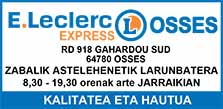Eric Quitugua / Rupert, Idaho, USA. Henry took over Etcheverry Sheep Co. on the very property his father ran. And as the older generations of Basque immigrants died and the local outfits shut down, Etcheverry remained one of the few Basque sheepmen left in Idaho.
It’s a point of pride.
But even as Etcheverry and the Magic Valley’s other second-generation Basques carry on some traditions of their mothers and fathers, they are vestiges of a culture that’s fading away, a culture once a big part of southern Idaho’s agricultural fabric and cultural diversity.
Sheep and Motivation
Etcheverry’s occupation is the one that explains the Basque presence in Idaho.
“There’s hardly a Basque in the West who hasn’t had ties to sheep,” Etcheverry said, counting newly shorn sheep in March.
In a large blue trailer, contractors pinned down sheep, running through their white, thick curls with clippers. Etcheverry waited outside in a holding area where the naked sheep wobbled out in a line.
He took count with a clipboard, then corralled his ewes to be branded. With tiny spray guns, Etcheverry and two of his employees, Peruvians with H2A temporary work visas, painted “M” and “22” on the sheep with a deep turquoise dye.
In his father’s day, the workers were Basque.
From the late 1800s through the 1930s, many Basques came to the American West to work on sheep outfits like Etcheverry’s. For many, economic prosperity was scarce in the Old Country, an autonomous area of the Pyrenees Mountains of northern Spain and southern France. Older siblings inherited the family ranches, leaving the younger ones with few prospects at home.
But the Magic Valley, like much of the western U.S., had high demand for sheepherders. It was a new, vast country where young Basques could thrive.
In Idaho, they found a high desert valley within reach of frigid mountains. Basques drove thousands of sheep through the mountains of Challis and Sun Valley, and the canyons of the Magic Valley.
Gallery: Vestiges of Idaho's Basque Culture
As the Magic Valley's first generation of Basque immigrants disappears, an identity is fading, too. Rupert sheep rancher Henry Etcheverry and the valley's other second-generation Basques are carrying on some traditions of their mothers and fathers. But they are vestiges of a vanishing culture, a culture once a big part of southern Idaho's agricultural fabric.
They traveled with wagons that served as their living quarters just like Etcheverry’s sheepherders do today. They kept everything — food, clothes and other necessities — in big sacks strapped on top of burros. They stayed in the mountains and hills for months on end. They had little contact with other people except the ranch owners who checked on them every few days.
They had next to nothing for entertainment — in the case of Etcheverry’s men, some magazines. The loneliness, he said, comes with the job. In the winter, towns like Rupert were simply places to go to church — typically St. Nicholas Catholic Church — or to pay bills.
“You get used to it,” Etcheverry said. “If you’re inclined to want to be in town and be around a bunch of people all the time, you better not be herding sheep.”
Life in the mountains was just about surviving and saving money. Some herders stayed in Idaho, working on short contracts before returning to Spain with money for their families. Those who made their homes in the Magic Valley included Etcheverry’s father, Jean Pierre, who first moved to Nevada as a teenager in the 1920s to work on sheep outfits before starting his own operation in Rupert.
“That’s what you call the American spirit,” Etcheverry said.
Protests in Spain
For many immigrants, coming to Idaho wasn’t about making a fortune in the sheep business. It was a matter of survival.
During the Spanish Civil War, close to half a million prisoners, mainly soldiers from the Spanish Republican military and other opponents of Francisco Franco’s Nationalist regime, were held in concentration camps.
Cities and towns were bombed by pilots loaned by Adolf Hitler. Thousands were killed in clashes between Nationalists and separatist groups, with blood spilling well past the civil war of the 1930s and into the ‘70s when Franco died.
Asun Bedialauneta, former treasurer of the Gooding Basque Association, lived in the Basque Country in the ‘70s during Franco’s rule. Born in Ondarroa in 1947, she recalled the repression of her culture.
“We were not allowed to be in groups of over three or four,” she said. “We were not allowed to speak Basque. We did anyway, but we were not allowed to.”
Bedialauneta remembered the day her stepbrother was imprisoned for nine months without reason. It was a Sunday morning, she said, and a protest for Basque freedom was planned. The town was full of tanks and machine guns. Organizers were intimidated by the military’s presence and called off the protest.
“In the evening we used to go disco dance,” Bedialauneta said. “When we were getting out at 9 o’ clock in the evening, (people) were saying don’t go downtown. Take a shortcut somewhere else.”
Police were taking people, she said, and her stepbrother was among them. For three days her family didn’t know where he was, but they soon found out he was jailed in Basauri.
While incarcerated, her stepbrother made a tampolina, a tambourine, that the people in jail with him signed. It says “to my loving mother” next to a date, 7-10-68.
Her stepbrother made the tampolina and more to sell for money for food in jail. Bedialauneta said she doesn’t know how she ended up with it.
“When I came here,” she said, “I brought everything I could.”
[sigue leyendo el artículo en MagicValley.com. Reúne asimismo una rica galería de fotos y videos]



 Enviar a un amigo
Enviar a un amigo Añadir comentario
Añadir comentario








